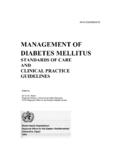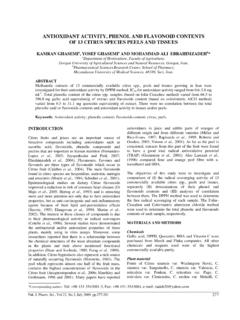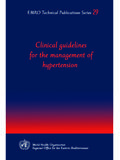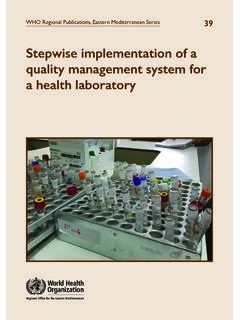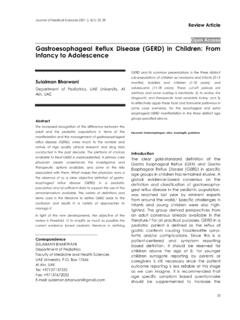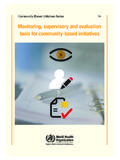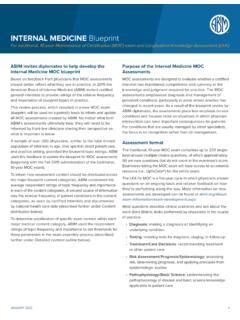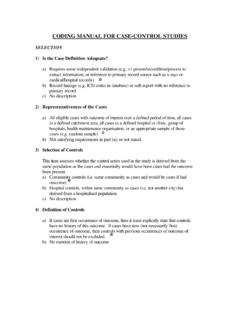Transcription of Clinical audit: A simplified approach
1 Journal of Pakistan Association of Dermatologists 2012;22 (4):358-362. 358 Address for correspondence Dr. Mansoor Dilnawaz Consultant Dermatologist Department of Dermatology Military Hospital (MH), Rawalpindi Email: Ph: +92 342 421 0568 Review Article Clinical audit: A simplified approach Mansoor Dilnawaz, Hina Mazhar, Zafar Iqbal Shaikh Department of Dermatology, Military Hospital (MH), Rawalpindi Abstract A Clinical audit measures practice against standards and performance. Unlike research which poses the question, what is the right thing to do? Clinical audit asks are we doing the right thing in the right way? An approach for understanding a Clinical audit is provided. A basic Clinical audit example of a case note audit is presented.
2 A simplified template to help the beginners is included. Key words Clinical audit. Introduction and steps of Clinical audit Audit is a key component of Clinical governance, which aims to ensure that the patients receive high standard and best quality ,2 It is important that health professionals are given protected and adequate time to perform Clinical ,5,6,7 Clinical audit runs in a cycle and aims to bring about incremental improvement in health care. Guidelines and standards are set according to perceived importance and performance is then measured against these ,9,10. A Clinical audit is NOT the same as research. There are differences (Table 1).
3 A Clinical audit usually starts by discussion at an audit team meeting discussing possible topics and prioritising them according to perceived importance applicable to the practice. The golden rule is we should only ever audit our own practice. If for some reason we need to gather data about the practice of others, then we should involve them in the audit and obtain their We should determine what we are trying to measure and define gold standards. The next stage is about setting the standards. Criteria are those aspects of care that we wish to examine. Standards are the pre-stated or implicit levels of success that we wish to achieve.
4 The standards are based on the local, national or international guidelines. They should be relevant to our practice. A couple of example of the sources includes National Institute of Clinical Excellence (NICE) and the British Association of Dermatologists ( ) web sites. When setting the standards remember the acronym SMART Specific, Measurable, Achievable, Relevant and Theoretically sound based on current research. Next, methodology should be defined. Who will be involved? Who will collect and analyse data? What will be the sample size? What about the feedback of findings to whom and how? When will the project begin and end? The audits and the data collection can be prospective or retrospective (Table 2) The audit once completed is presented at a meeting and recommendations are made with regards to deficiencies found and to identify areas for improvement.
5 The implementation of the changes cannot be over emphasized - What Journal of Pakistan Association of Dermatologists 2012;22 (4):358-362. 359 Table 1 Difference between audit and research. Research Audit Generates new knowledge Knowledge being used to the best effect Is initiated by the researchers Usually led by the service providers Is theory driver (hypothesis based) Is practice based (standard based) Is often a one-off study Is an ongoing process Large scale, prolonged periods Usually less so Lot of statistical analysis Not much analysis May involve allocating service users randomly to different treatment groups Never so May involve administration of placebo Never so Requires approval from ethical committee No such approval needed Table 2 Data collection.
6 Categories Retrospective Prospective Definition Data collected by looking back over your practice Data collected from this point onwards, starting at a future date When to use When looking at what has been happening in a chosen topic area Data currently unavailable Data of poor quality Advantages Can be faster Provides a baseline Avoids using poor quality data. Allows design of a clear and concise data collection sheet Disadvantages Past service users do not benefit Provides no baseline for audit. Can be time-consuming since a no of individuals needed to collect data Planning Audit Action Clinical Audit Cycle 1. Select topic 7. Implement change 8. Re-audit 2. Agree standards of best practice 3.
7 Define methodology 4. Pilot and data collection 5. Analysis and Reporting 6. Make recommendations Figure 1 Clinical audit cycle. needs to change? How change could be achieved what actions need to be taken? Who needs to take these actions? When will the proposed actions begin? How these actions will be monitored and by whom to achieve the desired outcome and then re-auditing to see if the desired outcome(s) has been achieved. Journal of Pakistan Association of Dermatologists 2012;22 (4):358-362. 360 A summary of the stages of Clinical audit are presented in the form of audit cycle (Figure 1) Discussion Clinical audit in simple words means are we doing the right thing in the right way?
8 This is achieved by measuring our practice and performance against standards. Doing regular Clinical audits is essential. Audits improve patient care, identify and promote good practice, lead to improvement in service delivery, demonstrate to others that our service is effective, provide opportunities for education and training and encourages teamwork. The overarching aim of Clinical audit is to improve service user outcomes by improving professional practice and the general quality of services There are three main types of Clinical audit: 1. Structure (what we need). This includes staffing and facilities.
9 2. Process (what we do). The examples are checklists, protocols, guidelines, record keeping, waiting times, trainee s attendance and treatment. 3. Outcome (what we expect) for example satisfaction surveys. Clinical Governance A Clinical audit is an integral part and key component of Clinical Clinical Governance is an umbrella term which encompasses a range of activities in which clinicians should become involved in order to maintain and improve the quality of the care they provide to patients and to ensure full accountability of the system to There are basically seven pillars of Clinical governance: 1. Clinical effectiveness This means ensuring that everything we do is designed to provide the best outcomes for patients doing the right thing to the right person at the right time in the right place.
10 In practice this means an evidence based approach , changing practice if current practice is shown inadequate, developing and implementing new protocols and guidelines, conducting research to develop evidence, CPD, maintaining log books, time management, seeking help where required, patient satisfaction surveys, adequate consultation time, information leaflets etc. 2. Clinical audit The aim of the audit process is to ensure that Clinical practice is continuously monitored and that deficiencies in relation to set standards of care are 3. Risk management This involves having robust systems in place to understand, monitor and minimise the risks to patients and staff and to learn from mistakes.
